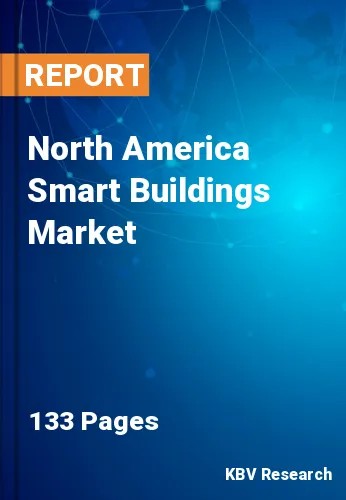
The North America Smart Buildings Market would witness market growth of 9.8% CAGR during the forecast period (2021-2027).
The need for smart buildings has been rising continuously as overall awareness of energy conservation has grown. Additionally, the use of green buildings and ecologically responsible infrastructure has resulted in the creation of smart and eco-friendly buildings, which regulate and effectively manage energy consumption in buildings across all sectors. In conference rooms, unoccupied offices, and other places, advanced devices such as smart thermostats, occupancy sensors, and HVAC and smart lighting can help in decreasing energy usage. As per the American Council for an Energy-Efficient Economy (AMCEE), Smart technologies will save 8-18% of total energy consumption in subsectors such as Class B offices, small chains, independent retailers, middle-tier franchise hotels, and others.
A smart city is made up of three levels that function together. The first is the technological foundation, which consists of a vital mass of smartphones and sensors linked together by high-speed communication networks. Specific applications make up the second layer. The correct tools are needed to turn raw data into alerts, insight, and action, and that's where vendors and app developers come in, together. Usage by cities, businesses, and the general public is the third layer. Many applications are only successful if they are broadly adopted and successfully shift behavior. They encourage individuals to take public transportation during off-peak hours, to vary routes, to by using less energy and water at various times of day, and to lessen healthcare system stresses by practicing preventative self-care.
Energy costs are rapidly growing, and environmental issues became a major concern in recent years. According to the US Energy Information Administration, business and residential buildings consume nearly 40% of the country's energy. One of the primary drivers for the adoption of smart building technologies has been the growing number of government efforts to reduce energy usage.
In addition, the Canadian government is putting a strong emphasis on energy conservation, particularly in smart buildings, such as offices and houses. Additionally, the United Kingdom has invested significantly in smart building technologies, especially to lower the building sector's carbon footprint and energy usage. North America is one of the key markets for smart buildings and IoT-enabled smart devices, and the region has seen an increase in the use and adoption of these technologies. Due to the sheer large number of recent consumers in the United States and Canada, North America holds a significant part of the market.
With growing energy costs and environmental awareness, an increasing number of Americans are searching for connected, smart, and automated building solutions with the inclusion of safety and alarm system capabilities, surveillance, fire safety, and security are most commonly installed goods. In the United States, IoT-enabled smart building technologies are also generally adopted. According to the Energy Impact Assessment, the average energy prices in the United States were 10.66 cents per kilowatt-hour, and this has been steadily increasing.
The US market dominated the North America Smart Buildings Market by Country in 2020, and would continue to be a dominant market till 2027; thereby, achieving a market value of $34,151.3 million by 2027. The Canada market is experiencing a CAGR of 12.3% during (2021 - 2027). Additionally, The Mexico market would exhibit a CAGR of 11.4% during (2021 - 2027).
Based on Building Type, the market is segmented into Residential, Industrial, Commercial. Based on Component, the market is segmented into Solution and Services. Based on Solution, the market is segmented into Safety & Security Management, Building Infrastructure Management, Energy Management, Network Management, and Integrated Workplace Management System. Based on Safety & Security Management Type, the market is segmented into Access Control System, Video Surveillance System, and Fire & Life Safety System. Based on Building Infrastructure Management Type, the market is segmented into Parking Management System, Smart Water Management System, and Elevator & Escalator Management System. Based on Energy Management Type, the market is segmented into HVAC Control System, and Lighting Management System. Based on Services Type, the market is segmented into Implementation, Consulting, and Support & Maintenance. Based on countries, the market is segmented into U.S., Mexico, Canada, and Rest of North America.
Free Valuable Insights: The Global Smart Buildings Market is Estimated to reach $131.5 Billion by 2027, at a CAGR of 10.6%
The market research report covers the analysis of key stake holders of the market. Key companies profiled in the report include Cisco Systems, Inc., IBM Corporation, Honeywell International, Inc., ABB Group, Siemens AG, Huawei Technologies Co., Ltd. (Huawei Investment & Holding Co., Ltd.), Intel Corporation, Hitachi, Ltd., Johnson Controls International PLC, and PTC, Inc.
By Buildings Type
By Component
By Country
Our team of dedicated experts can provide you with attractive expansion opportunities for your business.
